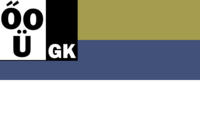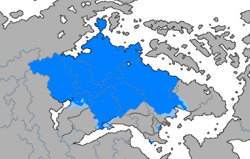Goeroek Language
This article is incomplete because it is pending further input from participants, or it is a work-in-progress by one author. Please comment on this article's talk page to share your input, comments and questions. Note: To contribute to this article, you may need to seek help from the author(s) of this page. |
| Language of Iron | |
|---|---|
| Gör Níyölm | |
 | |
| Pronunciation | /gørøk/ |
| Native to | |
| Region | TBA |
| Ethnicity | Görök, Görszák, Görky, Görkírsz, Elölött |
Native speakers | (L1: 5,440,000+ cited 0004) L2: 7,100,000+ FL: 135,000+ |
Níyölmanórsk
| |
| Dialects | |
| Latin script | |
| Official status | |
Official language in |
|
Recognised minority language in |
|
| Language codes | |
| ISO 639-1 | FS |
| ISO 639-2 | GRK |
| ISO 639-3 | – |
| Linguasphere | TBA |
 Distribution of the language throughout Görkírsk
Absolute majority >50% of native speakers | |
The Language of Iron (Görök: Gör Níyölm) is one of eight Níyölmanórsk languages, itself a part of the Görkök subgroup. The language was adopted as the national language of Görkírsk in 352 BW after the introduction of the Matyös Decree, that had resulted in the centralization of the First Görkírsk Kingdom under the reign of Jankoti II, during his national unification process. The languages history dates as far back as 4,000 BW, when the application of a modern writing system and more importantly the Goerkoek Runic Alphabet for the Görkök language, and later the introduction of the Latin alphabet to Görkírsk in 352, when latin writing was standardized and the runic alphabet faded into irrelevancy.
History
TBA
Geographic Distribution
The Görök language is one of the most widely spoken throughout the kingdom of Görkírsk, being the first language of five and a half million of the kingdoms citizens, and being the second language of almost eight million more. Despite being considered the "national" language of Görkírsk, It's brother and sister languages have a larger first-language speaker population in total when combined. The language has seen a steady decline since the end of the Great War, as the nations new constitutions abolished a number of important federal policies that had previously encouraged its spread. Mandatory teaching in schools was repealed after the introduction of the new constitution, and the Görkírsk Wars that plagued the nation in the aftermath of the great war caused a great deal of decentralization that would destroy the nations sense of unity, fueling separatist movements and motivating a number of influential cultural revitilization movements that prioritized the teaching of their native languages, rather than the national language.
Classification
The Görök language is universally considered to be the father of the Níyölmanórsk languages, being the direct successor of its predecessor, the Görkök language, which had a choppy and undefined vocabulary in comparison. The transition from the runic alphabet to the Latin alphabet and the states printing of dictionaries smoothed out the language and established rules and order that effectively modernized the language into what it is today. The Görök language is considered to be the simplest of it's brother and sister languages due to it's refined structure and fewer number of grammatical cases.
Phonology
Syntax
TBA
Alphabet
The transition from a Runic alphabet to a Latin script took place over the span of roughly three decades, beginning in the year 352 BW after the Matyös Decree. Today, the Goeroek alphabet consists of forty six letters, and fifteen vowels:
| A a | Á á | B b | C c | Cs cs | D d | E e | É é | F f | G g |
| H h | I i | Í í | J j | K k | Ky ky | L l | Ln ln | M m | N n |
| Ny ny | Nyl nyl | Nk nk | O o | Ó ó | Ò ò | Ő ő | Ö ö | P p | R r |
| Rsk rsk | S s | Sz sz | Sh sh | T t | Tr tr | U u | Ú ú | Ü ü | Ű ű |
| V v | W w | Y y | Yl yl | Z z | Zk zk |
- Language articles with old speaker data
- Languages without ISO 639-3 code but with Linguasphere code
- Languages with ISO 639-2 code
- Languages with ISO 639-1 code
- Language articles without reference field
- Language articles missing Glottolog code
- Language articles with unsupported infobox fields
- Goerkirsk
- Anderval